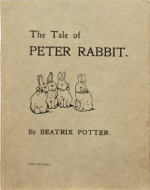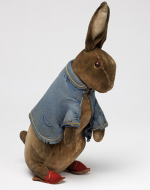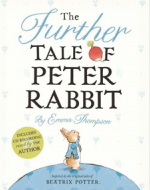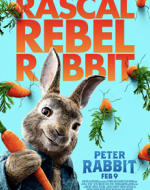Created by Eve Hyatt on Mon, 03/01/2021 - 18:40
Description:
Born in 1866, Beatrix Potter wrote a series of entertaining children's books, all containing charming and heartwarming animals embarking on exciting journeys. Her most renowned book is Peter Rabbit (1902), which follows the story of a rambunctious young bunny getting into all sorts of trouble. These books were favorites of many children as they encouraged curiosity, playfulness, and perhaps, most importantly, portrayed adorable animals. Potter was also different from other children's books authors in that she was as involved in the business and marketing worlds as much as she was in the writing and illustration of her books. She was aware of what made books popular and wanted to utilize the same strategies to bring the same successes to her series. A unique aspect of the 23 original tales of the series is the precision to detail that Potter demonstrates through her illustrations. As Potter was a farmer herself, her agricultural and animal drawings were consistently biologically correct, making them unable to be replicated by any subsequent artist of her work. Peter Rabbit's road to popularity and commercialization is a remarkable one and has led to many expansions in the series, in some cases losing touch with the original publication ("How Beatrix Potter Invented Character Merchandizing," Smithsonian Magazine, 2017).
Cover, The Tale of Peter Rabbit, by Beatrix Potter, Self-Published, 1901, Wikipedia.
When Beatrix Potter was ready to publish Peter Rabbit in 1901, she ran into some issues with publishers. Potter was insistent that her book be published in the way she wanted it: not rhyming, physically small, and inexpensive; Potter remarks, "little rabbits cannot afford to spend 6 shillings on one book, and would never buy it." Potter had been paying close attention to how and why children's books at the time were becoming popular, and she wanted to mimic those strategies through her own publications. Becoming frustrated with her rejection and unwilling to negotiate, Potter decided to go ahead and self-publish the book, ordering her own copies to be printed, hundreds at a time. When it began to sell well, Frederick Warne & Co, one of the publishers who had rejected her book, agreed to publish color copies. It was an instant hit with 28,000 copies being sold within the first year; the world quickly became familiar with Peter Rabbit and his family. (Potter qtd. in "How Beatrix Potter Invented Character Merchandizing," Smithsonian Magazine, 2017)
Beatrix Potter, "Early Peter Rabbit Plush," 1903, Peterrabbit.com.
Potter ran into another issue when her publishers failed to maintain an American copyright. Subsequently, her book was being printed and sold in the U.S. market, and she wasn't making any revenue from it. In order to make up for this loss, Potter had an idea to manufacture a Peter Rabbit doll and patent the idea, so that if anyone else tried to create a Peter Rabbit doll, she would be able to pursue legal action. In this way, she was able to make back a lot of money lost as well as bring forth a new way of merchandizing her series. This patent also marked the beginning of the commercialization of Peter Rabbit. Potter was aware of how expanding on the world she had created with toys, games, and sequels would contribute to the success of her original tale. The idea of patenting dolls and games was unsual for the time, and the success of her approach became a model for other children's series following Potter's model. She was able to combine creativity and a buisness-like approach to create a tale that is still popular today. ("How Beatrix Potter Invented Character Merchandizing," Smithsonian Magazine, 2017)
Eleanor Taylor, Cover for The Further Tale of Peter Rabbit, Taylor (2013), by Emma Thompson, Penguinrandomhouse.com.
When Beatrix Potter died in 1943, it was up to her publishers to take the series further. Potter's lifelong publisher, Frederick Warne & Co., was soon bought by Penguin, and Frederick Warne—who had worked closely with Potter—was no longer in control of the series or the future of Peter's world. Although Frederick Warne worked tirelessly to pursue legal action and earn back the rights to Beatrix Potter's images, the publisher was unable to stop spin-off books. In 2012, 110 years after the original publication of Peter Rabbit, Penguin published The Further Tale of Peter Rabbit, written by actor Emma Thompson with illustrations by Eleanor Taylor. Although we are once again introduced to Peter and his family, Beatrix Potter's presence is notably lost. Her dry wit is absent, and extensive knowledge of nature is turned into a watered-down version of the story, simply in hopes to capitalize off of Potter's ideas. Potter was betrayed by her own publisher in this way, and the spin-offs of her stories did not stop there. ("Peter Rabbit and the Tale of a Fierce Bad Publisher," The Horn Book, 2021)
Rascal Rebel Rabbit: Peter Rabbit, Sony Pictures Entertainment, 2018, Wikipedia.
Following the creation of spin-offs, toys, and even short cartoon animations inspired from Beatrix Potter's series came the Peter Rabbit movie, released in 2018. The movie follows both Peter's family as well as Mr. McGregor, who has a heart attack and dies early in the film. Instead of Potter's soft, detailed, and comforting illustrations, the movie uses computer animation to portray a harsher, less charming depiction of the animals. Absent are Peter's whiskers and endearing expression, changing Potter's original intent. Although a hope for the movie was that it would reignite nostalgia in those who had grown up with Potter's works, many of its viewers are too young to have ever read the original books. In this way, the movie is completely new, and besides the characters and a loose plot, its overprocessed nature has lost most of Potter's touch. Voice actors like Margot Robbie and James Corden keep a high profile and attract lovers of the actors instead of fans of Potter's work. The commercialization of the Peter Rabbit series has gone further than Potter likely ever imagined, and we can only wonder what Potter would think of the movie today. ("Peter Rabbit - Marketing Recap," Cinematic Slant, 2018)





